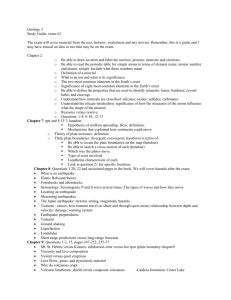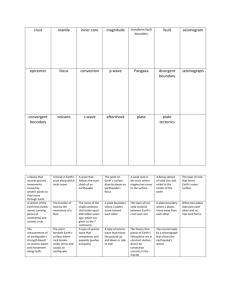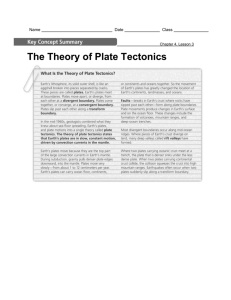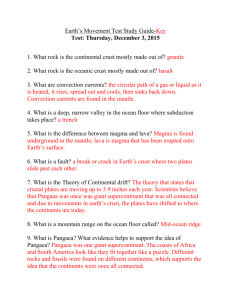The Restless Earth - Morecambe Community High School
advertisement
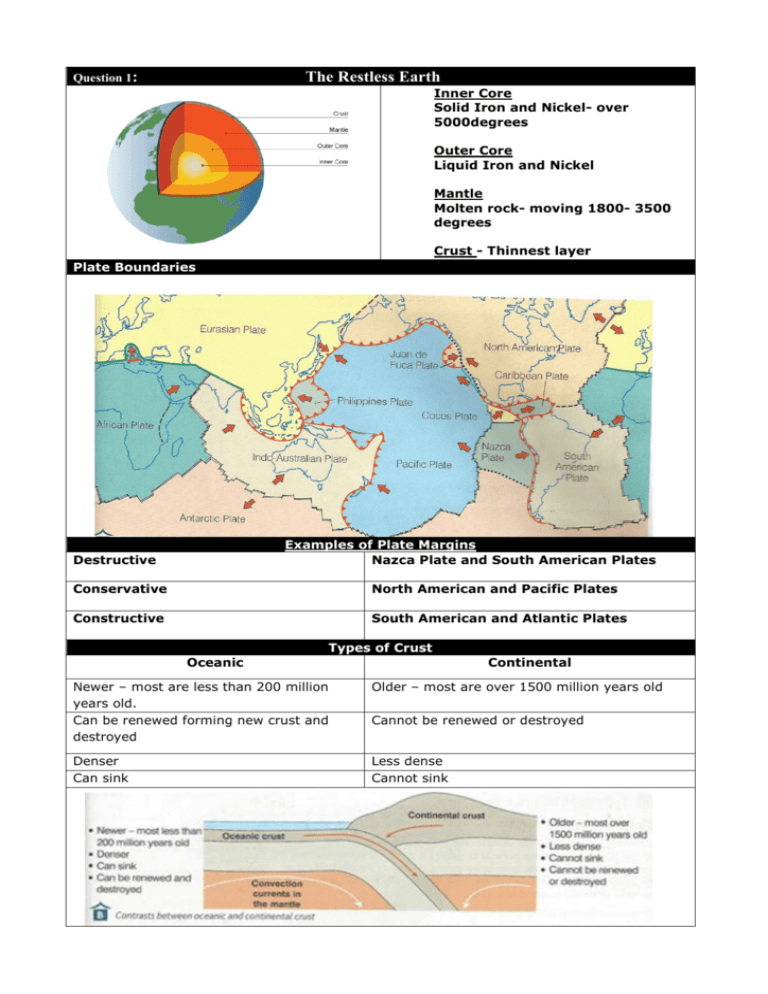
Question 1: The Restless Earth Inner Core Solid Iron and Nickel- over 5000degrees Outer Core Liquid Iron and Nickel Mantle Molten rock- moving 1800- 3500 degrees Crust - Thinnest layer Plate Boundaries Examples of Plate Margins Nazca Plate and South American Plates Destructive Conservative North American and Pacific Plates Constructive South American and Atlantic Plates Types of Crust Oceanic Continental Newer – most are less than 200 million years old. Can be renewed forming new crust and destroyed Older – most are over 1500 million years old Denser Can sink Less dense Cannot sink Cannot be renewed or destroyed Destructive Plate Margins Convection currents in the mantle cause plates to move together. If one plate is made from oceanic crust and the other from continental crust, the denser oceanic crust sinks under the lighter continental crust in a process known as subduction. Great pressure is exerted and the oceanic crust is destroyed as it melts due to friction to form magma. Key Words Subduction: the sinking of oceanic crust at a destructive margin. Collision: the meeting of two plates of continental crust. They are both the same type so they meet ‘head on’ and buckle. Constructive Plate Margin When plates move apart, a constructive plate boundary results. This usually happens under the ocean. As the plates pull away from each other, cracks and fractures form between the plates where there is no solid crust. Magma forces its way up into the cracks and makes it way to the surface and spreads out over a wide area to form shield volcanoes. In this way new crust is formed. Conservative Plate Margin At conservative plate margins, the plates are sliding past each other. They are moving in similar (though not the same) directions, at slightly different angles and speeds. As one plate is moving faster than the other and in a slightly different direction, they tend to get stuck. Eventually the build- up of pressure causes the plates to be released, causing them to jolt. This sudden release causes an earthquake. At conservative plate margins new land is neither created not destroyed. Landforms found at plate margins/boundaries Ocean Trenches Ocean trenches form some of the deepest parts of the ocean. They are found along destructive plate margins where the oceanic crust is pushed under the Continental crust. Subduction Young Fold mountains Young fold mountains are the highest areas in the world. They include ranges such as the Himalayas, the Rockies, the Andes and the Alps. Older fold mountains are less high due to erosion. Examples of these are the Cumbrian Mountains in the UK. Collision Rivers flow sediment into the oceans between plates Sediment forms layers on the ocean floor. The Plates push together causing the sediment to be compressed. Rivers continue to add more sediment. Sediments forms rocks that begin to fold upwards. This creates Young fold mountains. How do people use an area of Fold mountains? The Himalayas. Nepal, Asia. Home to 29 million people. On the Border between India and China. Home of Mount Everest. Problems experienced in Fold Mountain areas. Mountainous rugged terrain makes it difficult to build or farm on the land. Difficult to communicate between areas due to the steep relief and interference with cell phone transmissions. Tourists to the area leave large amounts of litter such as oxygen masks, tents and even dead bodies because it is hard to clean up in the tough conditions. It is difficult to provide modern services such as fresh water and electricity due to the difficulties constructing pylons and pipelines. Solutions Solutions - Tourism Tourism provides jobs for local people as Sherpa guides carrying the equipment of climbers. Earns £1600 for 60days. Also provides an income for the government who sell licenses at £50,000 for a team of 7 climbers. Mountains including Everest (8,800m) are vital attractions that bring extreme tourists and explorers to the area. Solutions- Hydroelectric power Only 30% of Nepal has electricity. HEP enables Nepal to dam off rivers in mountainous areas to provide sustainable energy to help develop the area. Solutions - Farming 76% of Nepalese are farmers. The steep relief makes rice farming difficult, so slopes are terraced to make the growing of crops easier. Farmers are mainly subsistence farmers and rely on growing crops for their own families to survive. Crops are mixed with goats and cattle due to poor soils. Government is encouraging production of cash crops to boost exports and help the economy. By increasing the amount of land for farming it has increased deforetation. Solutions - Communications By building cell towers on the peaks of mountains it enables point to point communications in difficult terrain. Building roads that wind to follow the relief, ski lifts and tunnels, it is easier to communicate between areas. Solutions - Mining Mining only accounts for 0.5% of nepal's GDP at present though surveys are being carried out to locate rich veins of rare earths/ gold and diamonds. Features of Composite and Shield Volcanoes Composite Volcanoes Shield Volcanoes Distribution of Volcanoes Volcanoes are an example of a natural hazard. Their spread relates closely to plate margins. The area around the Pacific Ocean is especially prone to volcanoes and is known as ‘the Pacific Ring of Fire’. Occasionally active volcanoes are found away from plate margins at Hot spots. Case Study of a Volcanic Eruption Soufriere Hills, Montserrat, 1997 Effects of the eruption Pyroclastic flow surprised and killed 19 people in a 500 degree burning firestorm. Half of Montserrat became uninhabitable. Homes and farms were covered in ash and destroyed. People were left homeless and forced to evacuate. Tourists stopped visiting the island due to fear and the devastation destroying tourist industry. Most of the islands infrastructure was destroyed including the airport and the port located in Plymouth. Capital Plymouth was buried under a giant mudflow - lahar, as rain mixed with ash from the eruption. Quartz in the ash led to an increase in health problems such as silicosis of the lungs. Responses to the eruption - Immediate Response to the eruption - Long term 8500 people were evacuated off the By 2010 1500 people had returned island to places such as the UK for safety. increasing the population to 5000 people. British government was forced to protect the territory providing millions of pounds of aid for food, water and emergency shelter. Many younger people left and never returned, this had led to an imbalance with the population made up of mainly older people. This will create major problems in the future. An exclusion zone was setup around the volcano with the population forced to evacuate to the north of the island. The British government built a new port in the north at Little Bay to bring in supplies and restart the economy. The Capital Plymouth was evacuated to avoid Ash and mudflows. Monitoring Future Eruptions Scientists will use tilt meters to measure the shape of the volcano and to detect changes. Measuring sulphur dioxide emissions enables scientists to detect a build up of gas prior to an eruption. Using seismographs means that they can detect tremors that could signify an eruption is imminent. What is a supervolcano? Size Shape A supervolcano is a mega volcano that erupts at least 1,000km³ of material. Have large depressions called Calderas Very wide- Yellowstone is 64km Have steep mountain ridge around them How do They Erupt? The effects of a super volcanic eruption e.g Yellowstone The likely effects of an eruption INITIAL EFFECTS: the clearing of any tourists in the national park and any one in a 100 mile radius. The park would be closed. The volcano would erupt fine materials, shooting them up 80,000 feet into the air. Pyroclastic flows would spread about 50-100 miles, killing and destroying everything in its path. Small earthquakes would shake the ground causing damage. A hurricane of ash is likely and rock as hot as 1200 degrees would come out of volcano. Parts of NW America would be completely destroyed. The worst hit area would be Montana. There would be lots of ash (1000 times that of Mt. Helens) and buildings would be covered with up to 30ft of ash. The ash made of small shards of glass would destroy humans and animals lungs. Masks would have to be worn. If the ash rose aero planes would have to be grounded and any flying could risk the engines failing midflight. Growing crops would become difficult too. Worldwide travel would cease and day would be turned to night. It would alter the climate and make everywhere much colder. Up to 15 degree drop in global temperatures. The ash would stay in the atmosphere for up to 6 years and worldwide trade would be affected too. Sunlight would be blocked out leading to loss of crops, hunger, famine and enormous loss of life. Up to 1 billion people would die. What are Earthquakes and where do they occur? The place where earthquakes begin, deep within the earth’s crust is called the focus; deep-focus earthquakes cause less damage and are felt less than shallower ones. The point above the focus where the earthquake is most strongly felt is called the epicenter. Radiating out from the epicentre are shockwaves / seismic waves. Measuring Earthquakes The Richter scale The strength of an earthquake is usually given according the Richter scale. Measured using a seismograph as it happens. There is no upper limit and the logarithmic scale means that there is a 10 times increase in power between number. 1>2 = 10x more powerfu 1>3=100x more powerful The Mercalli Scale Measured using Scientific observations after the earthquake has happpened. Uses Roman numerals on a scale of 1-12 I -XII It measures the power and effects of the Earthquake. Examples I = Only felt by scientific instruments V = Windows would break XII = Everything would be destroyed Response to an Earthquake - Rich Vs Poor Haiti - Poorer Country Chile - A richer Country Haiti is in the Caribbean Chile is in South America. Ranked 143rd for GDP. Ranked 46th for GDP. Very poor- hit 12 Jan 2010 by a 7.0 earthquake. Rich - hit 27 February 2010 by a 8.8 Earthquake Primary effects Haiti - Poorer Country Chile - A richer Country 220,00 killed, 300,000 injured. 500 killed, 12,000 injured. Main Port (Port au Prince) was destroyed cutting off Haiti 500,000 homes damaged, Several bridges and roads destroyed. 1.3 million left homeless after 1million homes destroyed Secondary effects Haiti - Poorer Country Chile - A richer Country 2 million left without food and water. Chile lost power for up to 9 days. National emergency. Hit by a small Tsunami Looting became a problem as people tried to survive. There was a chemical fire in Santiago. Aid could not reach Haiti and Cholera had taken hold by November. People were forced to live in tents. Immediate responses Haiti - Poorer Country Chile - A richer Country Slowed and hampered by damaged port and roads. Requested help from other countries- aid, medical teams. UN sent troops and food for 2 million people. 10 days later 90% of homes had electricity Bottled water and purification tablets were given to survivors. US divers set about repairing the port. $60million raised in a national telethon to help those affected. Repaired important roads within 24hrs to transport aid and rescue machinery. Long Term Responses Haiti - Poorer Country Chile - A richer Country Reliant on overseas aid indefinitely. New homes were to be built but would costs $billions. Required massive investment to restore water and electric services. 1 month after the quake, the government began rebuilding and repairing 196,000 homes. Used its huge copper reserves to pay for the reconstruction efforts. Protection and the future Haiti - Poorer Country Wasn't prepared- too poor and no recent earthquake. Overcrowded with poorly built houses that easily crumbled. Government was too poor to prepare. Chile - A richer Country After quake in 1960 Chile had prepared. Education and training taught people to drop, cover and seek safety. Government runs regular disaster drills to prepare Case Study: Indian Ocean Tsunami 2004 Cause When 2 plates collide and lock out at sea. Pressure builds up between the plates due to friction. Pressure is released causing plates to jolt. This causes the water above the plates to be displaced. This creates a massive wave Tsunami The Tsunami travels outwards in all directions at over 800kmph. As the wave reaches the shore it gets shallower causing it to slow down. This causes the wave to rise by 10-20m and then break. Effects Hit by 9.0 Earthquake that created Tsunami in the Indian Ocean that hit 12 countries. 300,00 people killed by the wave including 236,000 in Indonesia. Sumatra was the closest island to the epicenter. 70% of the coastal population was missing or killed. 400,000 people lost their jobs as coast was ravaged. Farms destroyed, fishing boats smashed and the economy collapsed in a matter of minutes. Tourist resorts hit with 1700 killed. Led to collapse of tourist industry through fear and loss of resorts/ hotels. Arable farmland was contaminated by salt water that killed off the crops. Responses - Immediate Clean water, food and shelter were sent by an international charity campaign, along with key countries such as the United States. $7 billion dollars was donated worldwide with $330million coming from the UK. The money was used to begin cleanup operations and reconstruction of the devastated communities. The United Nations provided food for over 1.3 million people to fend of starvation and help the area to recover due to loss of farm land from salt water contamination. Responses - Long Term A tsunami warning system was setup in the Indian ocean to send messages to all neighboring countries. Bells, megaphones and speakers have been installed in coastal destinations to provide warnings and to stave off future disasters. Mangrove swamps were re-grown to act as a natural barrier along the coast to absorb the impact of future tsunami's. Mangrove swamps act as a breeding ground for fish and by restoring them it created new fishing jobs. Convection Currents Heat from the core causes the magma in the mantle to warm and rise. As the magma reaches the crust it is buffered and causes the plates to move As it cools the magma returns to the core to repeat cycle.






